
たつ屋
Tatsuya
3.60
Ebisu, Imamiya, Ashihara
「Hot Pot」
2,000-2,999円
--
大阪府大阪市西成区山王1丁目17-10
Photos
(20)

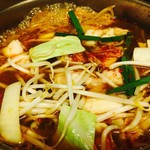















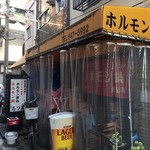


Details
Reservation Info
No Reservations
Payment Method
No credit cards
Electronic money is not accepted
Number of Seats
19 seats
Private Dining Rooms
None
Smoking and Non-Smoking
Smoking is permitted in all seats. As the Law Concerning Measures Against Passive Smoking (Revised Health Promotion Law) has been in effect since April 1, 2020, please check with the restaurant prior to your visit as the information may differ from the latest information.
Parking
None
Facilities
Counter seats available
Drink
Sake available, shochu available, wine available
Comments
(21)
bottarga
4.50
This is a famous hormone restaurant located in a back alley near the zoo station. It was my first visit. In places like Hakata or other regions, they serve motsu nabe or simmered motsu, but in Osaka, especially in the southern part of the city, it's all about hormones. It feels like stepping into the world of Jarinko Chie. When I went around 6 pm on a weekday, there was no line, but the restaurant was full. I waited outside, and more people joined the line. After about 20 minutes, I got a seat. The interior of the restaurant has partitions between the seats, and they have spaced out the seating quite a bit. Surprisingly, they have taken thorough measures for infection prevention, which is a bit of a wait. Inside, there is a TV showing the Hanshin Tigers game. We ordered hormone simmered dish, raw intestines, hormone hot pot, Chinese noodles with raw egg added, and also a draft beer. It cost just over 2000 yen and we were very full. The first dish that arrived was the hormone simmered dish. It didn't look very appealing, but it was incredibly tender and delicious, with no unpleasant smell. I even thought it might be tastier than the best izakaya in Tsukishima, Kishidaya. The raw intestines were also fresh and tasty, with a spicy red miso sesame oil sauce. Both of these dishes have quite a substantial portion size. One plate is just right for two people, and it might even be enough for three. The hormone hot pot contained various parts of beef hormone, several types of pork, leeks, cabbage, tofu, and kimchi, giving it a kimchi hot pot flavor. We finished by adding Chinese noodles and eggs. The quality of the hormones here is definitely high, and while the taste is reminiscent of B-class cuisine, it is of a high level. Unlike the flavor of motsu nabe in Hakata, this one is delicious and can be considered a top-notch Osaka specialty. Everything was delicious, but among them, the hormone simmered dish stood out the most in terms of taste. So far, for people visiting Osaka, the most recommended dish at an affordable price was the oden at Hanakujira, but now this place has also become a recommendation. I think it's worth a visit even for people from other prefectures.




みっち87879
3.80
I wasn't satisfied with the earlier restaurant I visited, so I came to this place in search of delicious hormone dishes. I didn't realize they opened at 11:30, so I arrived 30 minutes late! The restaurant was full and there was even a line outside. After waiting for 20 minutes, I finally got a table! This time, I tried adding Akasen to my order. It's a mix of mino and shimachou, and it was quite delicious! Even when I finished eating and left, despite the hot summer weather, there were still people waiting in line! I will definitely visit again.



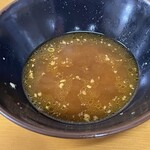
みっち87879
3.70
To relieve summer fatigue, I searched for a hormone restaurant on Tabelog and decided to visit this place. I ordered the hormone stew and looked around the restaurant. When the hormone stew arrived, I was surprised to find that it was light and easy to eat, with no strong taste. I didn't realize there were hormone restaurants like this! I went with a friend and we decided to order the delicious hormone hot pot with vegetables. Even though it was meant for one person, the portion was huge and our appetites were at their maximum. We finished off with Chinese and udon noodles to fill our stomachs to the fullest. We will definitely visit again!



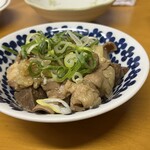
紅サソリ
4.00
In the middle of Mount Rokko, there is an old Western-style building covered in ivy called Merry's Mansion in the New World. It's quite hard to find. The Tatsuya restaurant in the same area is also not easy to spot from the main street. You can only tell by the impressive sign and a note on a bicycle parked in the back alley for business hours. Truly, it's like Merry's Mansion in the New World. The hormone udon here is excellent, so please try it for 370 yen.




なにわナンバー
3.80
I ordered the following menu: Hormone hot pot, steamed pork, small rice, kimchi, green onions, raw egg, and two oolong teas. It only cost 2,000 yen! I arrived just before 7:30 and managed to get a table. When I asked the staff about the closing time, they mentioned that it depends on the head chef's discretion. By the time we finished eating, the closing sign was already put up. I recommend arriving before 7:30. Thank you for the delicious meal, Tatsumiya!




またまた東京単身赴任中
3.50
Jime-chan wanted to go to the zoo for a pre-visit for the nursery school field trip, so we decided to stop by Tatsuya for some hormone hot pot. Luckily, we arrived after 5:00 PM, so we didn't have to wait too long in line for the second seating. The food was really delicious! Thank you for the meal.



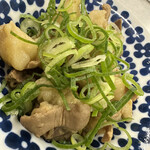
なにわナンバー
3.80
Ordered menu☆ Oolong tea 150 yen☆ Grilled pig's feet 450 yen☆ Hormone hot pot 950 yenAs always, the hot pot was reliably delicious. The kimchi side dish was also of very high quality. Thank you for the meal! Thank you, Tatsumiya!




crew_value
3.90
The delicious hormone hot pot available at the Zoo-mae Station is located in a somewhat hard-to-find place with a unique exterior. I ordered the Hormone Hot Pot for 2 people, priced at 950 yen per person, which is very reasonable. It includes various types of hormone, cabbage, leeks, tofu, and other ingredients with a soy sauce-based broth that is incredibly delicious. Adding Chinese noodles at the end is a great deal. Many people were enjoying solo hot pot meals here. This is a place I would definitely want to visit again.



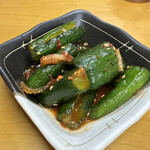
またまた東京単身赴任中
3.50
When I arrived at the zoo, I first peeked into Tatsumiya and saw that it was crowded, but it was open! So, I decided to come back later to avoid the line. When I returned an hour and a half later, I thought I was the only one in line, but then I saw a sign saying that the store was closed for the day. I asked someone in line if I had missed it, and they said it seemed like the store was closing, but the owner came out and asked if I still wanted to wait. I said it was okay, and surprisingly, I only waited about five minutes before I got to enjoy Tatsumiya's hormone hot pot for the first time in seven months. Today's dishes were hormone hot pot x2, cucumber kimchi, champon noodles x1, zosui set x1, draft beer x2, lemon highball x2. It was delicious! I wonder when I'll be able to eat here again.




Thomas77502
3.50
The atmosphere may be a bit intimidating, but the food is delicious. The chef may not be very friendly, but that adds to the charm. If you want to experience old-fashioned Osaka, this is the place to go. They seem to have irregular closing days, depending on when they can source their ingredients.


katka(かてぃか)
4.30
When flying to Osaka from Peach, use the Nankai Electric Railway from Kansai Airport and get off the train at Shin-Imamiya, just before Namba. When you go down to the platform and exit onto the street, you will see old men smoking on the street, even when it's over 20℃, wearing coats and riding bicycles. You will see dirty old men sitting under traffic lights or guardrails. The scenery is a bit different from the Japan I know, but it's still recognizable. Living without getting your hands dirty is impossible, and growth involves accepting both the good and the bad. Sometimes you get swept away by the waves, swallowed up, dragged into the deep sea, and eventually washed up on the beach. I think this area is probably like that. In such a place, there is a restaurant that I admire as a "sacred place" called "Tatsuya." This place was recommended to me by someone I no longer remember, back when it was a pretty scary area and I didn't feel like going alone at night. Even though the area has become more touristy now, I still went prepared in all black to avoid any trouble. The restaurant was crowded, but luckily I got a table without waiting. Inside the restaurant, the long-used and polished counter was in the center, with chairs spaced far apart as always. The table I was seated at had been replaced with a new one. Despite being in a tough neighborhood, the atmosphere inside the restaurant was very welcoming. I hadn't eaten anything since morning, but I held back my hunger for what was to come. I ordered a large beer and simmered offal. In Kanto, offal stew is sweet and salty, often with a lot of broth, but in Kansai, it is more like a soup similar to udon broth, and this restaurant was no exception. The soup was light and just a little bit included. The offal retained its fat, unlike in Kanto where the fat is removed, and they use fatty horumon (offal) and chewy fugu (blowfish). When you pick up a piece of offal and put it in your mouth, the fugu absorbs the soup and when you chew, the juice comes out with a crunchy texture. The offal has a rich flavor from the fat, and when combined with the soup, it tastes amazing. Reset the oil with the bitterness and carbonation of the beer. I repeated this process a few times, and before I knew it, the delicious stew was gone. Next up was steamed pork. This restaurant uses skin-on shank meat as the base for its yukhoe (boiled meat slices), which comes with a vinegar miso called chojang that is similar to the sauce used for choppal. It's tangy, spicy, and goes well with alcohol, but the steamed pork at Tatsuya is closer to Korean bossam and comes with kimchi. The kimchi at this restaurant is so good that it could be used for bossam. However, unlike bossam, it comes with bean sprout namul instead of wrapping leafy vegetables. The kimchi pairs well with the steamed pork, and the crunchy texture of the sesame oil-flavored bean sprouts adds to the deliciousness. Putting the kimchi and namul on the steamed pork and taking a bite, the rich flavor and taste are amazing. Reset with another beer. I wanted to order one more dish, but I had plans for beer and snacks later. Normally, you would move on to horumon nabe (offal hot pot) from here, but I had to consider what was coming next, so I ended my meal here. It was disappointing, but unavoidable. After settling the bill and leaving the restaurant, I stepped out onto the street and saw the old men again. There is a zoo nearby, but watching the old men on the street is just as entertaining. Tatsuya is a long-established offal hot pot restaurant located in such a place.


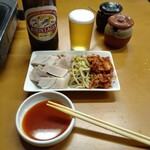

ヨシsan
4.50
After a long time in Osaka, if you come all the way to Osaka, you can't miss Tatsuya. I visited in the early afternoon on a weekday and since I was alone, I was able to enter without waiting. I ordered a draft beer, hormone simmered dish, and hormone hot pot. The simmered dish was tender and delicious! It went well with the beer. And the hormone hot pot was consistently delicious as always. It has a rich flavor and is slightly spicy. Adding a little garlic makes it even more delicious. I also added a lemon chu-hi. I finished with the usual Chinese rice. It was good to be able to eat here again after a long time. I think I can do my best for a while now (laughs).




viehcle
4.00
I decided to enter the restaurant when I passed by and saw that it was still open with only three customers waiting. It was my first time visiting this place, and I had heard good things about it. The prices were also very reasonable, so I was excited to try it out. I got seated in about 15 minutes since I was dining alone. I ordered the motsunabe (offal hot pot), Chinese noodles, and a cider. The fact that the cider was only 150 yen was very reasonable. The hot pot was ready in less than 10 minutes. I tried the soup first, and even though it was spicy, it was incredibly flavorful! The secret broth was truly amazing! The hot pot had various types of offal, pork belly, and pork loin, along with cabbage, leeks, tofu, and bean sprouts. Many people around me were ordering the Chinese noodles, so I decided to get them too. The offal was cut into small pieces, making it easy to eat and enjoy a variety of flavors. Even for someone new to offal, it was enjoyable. The Chinese noodles were also delicious. It would probably be great to pour the broth over rice as well. I will definitely try that next time! The restaurant is located just off the main street, so it doesn't have a scary atmosphere. However, the entrance of the restaurant looks quite old, which might give off a slightly hesitant vibe, but once you step inside, you'll feel the nostalgic Showa-era okonomiyaki restaurant ambiance. There were mostly male customers, and when I visited, there were around 10 customers, with only one person dining alone like me. The offal was very easy to eat, so I highly recommend it to female customers as well. The order was taken by a young and friendly lady. The total bill came to 1,270 yen, with the hot pot at 950 yen, Chinese noodles at 170 yen, and cider at 150 yen. I was very satisfied!




nama692
3.90
The location and appearance of the restaurant near Dobutsuen-mae Station are unassuming, and the prices are affordable. However, the taste is sophisticated, with fresh ingredients and careful preparation. The clear soup is filled with the savory flavors of vegetables and offal. It's a shame that it's unclear when they are open and reservations are not accepted, but it's a hidden gem that you'll keep coming back to.


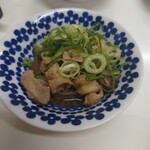
やまも1113
3.50
- Hormone hot pot for 950 yen: A soy sauce-based soup with hormone meats such as teppanyaki and red liver, along with kimchi, leeks, bean sprouts, vegetables, and tofu. The portion for two people was quite generous.
- Steamed pork for 550 yen
- Hormone stew for 350 yen




にゅん♪♪
3.70
The task was given by the office clerk O-san, and all the tasks from O-san are related to bars. This hormone hot pot (suitable for one person) is highly recommended. The restaurant is located in the so-called New World area, and although the person has only been there once, the impression left was quite good. The opening hours are from noon. It is a popular restaurant, but there shouldn't be a huge line (which was true in my case). The restaurant is located near where I pass by frequently.
The restaurant is surrounded by a vinyl sheet, giving off a very New World vibe. The interior is very Showa era, with a counter seat where I ordered the hormone hot pot for 950 yen (tax included). The staff asked if I wanted a drink, but I bravely opted for water (I was the only one drinking water).
The hot pot started with all the fresh ingredients in the pot, clearly a generous portion for two. I started eating at my own pace once the meat was cooked. The hormone was fresh, and as it cooked, the flavor got richer. The hot pot was filled with a variety of vegetables, making it a balanced meal. I ended the meal with udon noodles for 170 yen (tax included), which were a bit thin and prone to getting soggy, but it added to the overall experience.
The overall satisfaction for a hot pot under 1,000 yen was high, and it was delicious. Thank you for the meal.
Additional notes:
1. On Saturday, I arrived 5 minutes before opening and there were already about 10 people in line, enduring the extreme cold.
2. I thought I could get in around the first round of opening, but I was mistaken.
3. The restaurant opened a bit earlier than usual, and by the first round, the place was already full, leaving others waiting.
4. After waiting for about 30 minutes, I, as a solo diner, was prioritized over group customers and seated.
5. The reason became clear when I entered the restaurant, as there were only about 5 counter seats available.
6. The counter seats were mainly for solo diners or pairs, with quick turnover, while the tables for 4 were occupied by groups that stayed longer.
7. Groups of 3 or more should be prepared for a 1-hour wait, as it is a common occurrence in this restaurant.




いっちゃん1014
4.60
I came back after a long time to the best horumon nabe in Japan. I haven't been eating out much, so I don't know (^。^) The appearance is not exactly beautiful. But the horumon is incredibly sweet and tender. The chef is also kind of cute. And most importantly, it's so cheap! Two servings of horumon nabe, four drinks, chanja, chuka tamago, zosui set, all for just 4000 yen. It was a very satisfying Christmas Eve. Thank you for the meal ♪




ヨシsan
4.50
I visited my favorite yakiniku restaurant, Tatsuya, after a two-year absence in Osaka. It was crowded inside, but there was no wait outside during lunchtime on a weekday. I ordered a draft beer and hormone hot pot. The hormone hot pot had a soy sauce base with a rich flavor, just as delicious as always. For dessert, I had the usual Chinese dumplings. They were incredibly delicious! I'm glad I was able to enjoy the delicious hormone hot pot after a long time.




なにわナンバー
3.80
I ordered the following menu:
- Hormone hot pot 950 yen (tax included)
- Raw intestine 470 yen (tax included)
- Makgeolli 450 yen (tax included)
- Oolong tea 150 yen (tax included)
- Small white rice 150 yen (tax included)
- Raw egg 50 yen (tax included)
Kimchi and green onions were served as a service. The porridge was excellent! Thank you for the meal! Thank you very much, Tatsumiya!




またまた東京単身赴任中
3.50
It's been a while since I returned to Osaka, so I decided to take my wife out for a meal. First, we checked out Tatsuya... Oh, it's busy! And there are only two people in line! Alright, let's try Bouma next. It looks like they just started the first round, so maybe about a 40-minute wait? A single person got seated before us, but that's okay. Finally, after a 45-minute wait, we got seats at the corner of the counter. We ordered hormone hot pot x2, simmered cucumber kimchi, champon noodles, and zosui set. It was delicious as always. Bon appétit!


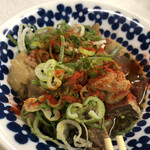

スルメイカ
3.50
7/2022 It's been half a year since I last visited. The hormone hot pot here is truly one of a kind. I enjoyed dipping the Chinese cabbage in raw egg. It was delicious.
1/2022 This is a restaurant I really love, but I felt like the hospitality was lacking a bit this time. It could be due to the current circumstances, but I appreciate that they are open during these difficult times. I will visit again.




Email Login